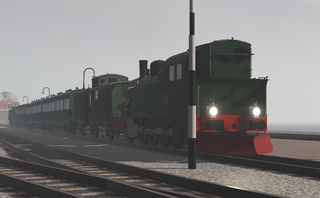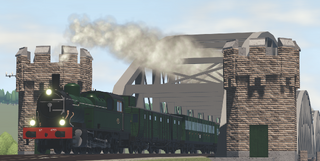 | |
| NS 6200 | |
|---|---|
| by Supersnel11 | |
| Price | ƒ70.000 |
| Level | 22 |
| Statistics | |
| Type | Mixed |
| Top Speed | 60 km/h |
| Weight | 91 tons |
| Capacity | 440 tons |
| Passenger Capacity | 1 first class 2 second class |
| Length | 13,1 meters |
The NS 6200 was a class of 40 German designed, Dutch 1'D'1t (2-8-2T) goods locomotives mainly used to transport coal trains through the hilly terrains of the province Limburg.
Variants
The NS 6200 is only available in Nederlandsche Spoorwegen green.
Technical Details
The SS years
In the early years of the Maatschappij tot Exploitatie van de Staatsspoorwegen (SS), the coal trains in Limburg were of little concern. Their 1B series SS 9 - 16 could handle the inclines there with ease. It wasn't until the goods transport in the region increased that these machines had to doublehead the heavy trains or even push-pull them over the hills. This was kept up for some time because the lines had a maximum allowed axle load of 12,5 tonnes. Once the lines were upgraded, the Staatsspoorwegen began looking for locomotives. The choice fell onto tank engines as the distances were short enough to be driven without tender, with the added bonus that no time would be spent turning them around on turntables.
Six 1'D'1 locomotives were ordered at Hohenzollern and numbered SS 1101-1106. These arrived in May, 1912. Although these machines were meant to drive the line between the Dutch Sittard and the German Herzogenrath, but were also used elsewhere. So, the SS ordered another 20 (SS 1107-1126) in 1913 and yet 14 more (SS 1127-1140) in 1914.
The SS 1115-1140 were delivered with superheaters fitted.
The NS years
Pre-war
After the fusion between the SS and HSM, the locomotives without a superheater were stationed at the depots Armehm, Emmerik, Weert, Enschede and Oldenzaal where they took care of goods trains around the border with Germany. The superheated machines were stationed at the Southern Limburg depots Maastricht, Heerlen and Susteren. Their good performances as humping locomotives was cause to station them at other depots too: Amersfoort from 1933 onwards, Nijmegen from 1926 onwards and Hengelo from 1932 onwards, where they pulled goods trains to the German Gronau and Bentheim. The majority of the class remained in the South of Limburg, even after the NS 6300 took over their most important work. Although some were moved to the depots Fijenoord and Roosendaal. In the latter they were put on the beets train.
Even though the machines were designed for goods trains, they were accidentally also put on passenger trains. Mostly work-trains between populated areas and industrial zones.
Throughout their NS life, they were nicknamed "Bokken" (goat bucks) by personnel because of their fast yet wild acceleration.
The war
When the German army retreated from Limburg, they destroyed seven 6200s in Heerlen and another in Maastricht and took 16 others with them. Among those was NS 6222, which ended up in the Russian occupation zone. She was scrapped in April of 1951, but was in service until then. The other 15 were returned to the Netherlands, repaired and put back into service.
Post-war
Of the machines that the Germans left within the Dutch borders, eight (NS 6201/09/13/14/20/24/29 & 6230) were too badly damaged to be repaired and were send to the scrapyard in 1947.
The remaining 31 were kept in service in the South of Limburg and for humping in the depots Watergraafsmeer, onnen, IJsselmonde and Amersfoort.
The withdrawal of the series started in 1952. The last eight were withdrawn in 1957 after being the image of the railways in Limburg for nearly 45 years.
Technical details
The NS 6200 were originally equipped with: Westinghouse-brakes (automatic and independent); Bissel-axles on the leading and trailing wheel; an air-powered bell; coupling for steam heating on the front and back; two injectors and the firebox was secured with a Ramsbottom-mechanism.
The basic design of the class was done by Hohenzollern, though it was adapted to the requirements and customs of the Staatsspoorwegen as much as possible. The SS 1101-1114 (later NS 6201-6214) were not fitted with a superheater because of budget cuts, but they still received theirs between 1922-1924. This was done by Werkspoor.

Additionally, the first 14 locomotives did not have a coal bunker with edges that curved outwards. The others did to compensate for the slightly smaller water tanks and weight of the superheater. Around 1930, the whole class was equipped with higher coal bunkers, which increased their capacity from 2,5 tonnes to 4 tonnes.
From 1918 onwards, they were fitted with Knorr pre-heaters with a heating surface of 9,2 m² and a pump with a capacity of 120 litres a minute. Unlike most that received the pre-heater, these machines kept their second injector. Some of the pre-heaters were removed in 1943 due to a lack of spare parts.
The Bissel axles that were used were a special design. They were essentially single-axle bogies that could even move sideways a little without getting stuck in parts of the frame.
The 6200s received a modification in 1938 for which the sand storage, placed inside the frame, had to be moved. This was moved to the front of the water tanks.
Trivia
- The NS 6200 is a mid level tank engine, suited to slow and heavy goods train, but also capable to pull passenger trains.
- The NS 6200 is currently the slowest non-shunter locomotive in the game, with a top speed of 60kph, only 5kph below many other freight locomotives.
- The NS 4500 would have run even slower, at a measly 50kph, in the time period the game was set in.
- The NS 6200 has the largest capacity of all the mixed locomotives, at 440 tons.
- In version 0.3, the NS 6200 received a temporary snowplough livery for the winter season of 2020.
- Strangely, the snowplough has not returned for any subsequent winter updates.
- The NS 6200 has been available since the game's launch, version 0.1.
Gallery
-
An NS 6200 with the snowplow leaving Zand op 't Zee.
-
An NS 6200 locomotive leaves the Kesteren bridge pulling a passenger train.
-
An NS 6200 and NS 3400 working together to haul a heavy goods train.



